Nobel Prize winners talk research, Nobel ceremony, and are remembered by U-M colleagues
From rubbing elbows with royalty to finding yourself a casual seatmate to a member of U2, Professor Emeritus Gérard Mourou, Prof. Donna Strickland, and their former U-M colleagues shared their experiences and reflections on the 2018 Nobel Prize ceremony.
What do you wear to a Nobel Prize ceremony? How do you explain to other people what you did to win the most prestigious scientific prize in the world? What do you say to a king when he escorts you to a banquet?
These questions and more were addressed by 2018 Nobel Laureates Gérard Mourou, the A. D. Moore Distinguished University Professor Emeritus, and Prof. Donna Strickland, Mourou’s former graduate student, when they visited campus as distinguished lecturers for Biomedical Engineering and Physics on October 30th and November 1st, respectively, this fall.
The Work
Mourou and Strickland won the Nobel Prize in Physics – the most prestigious of all the Nobel prizes – in 2018 “for their method of generating high-intensity, ultra-short optical pulses.” They did this with their invention of chirped pulse amplification (CPA).
CPA is a method of generating high-intensity, ultra-short optical pulses and has many practical applications such as accelerating protons for proton beam therapy (which is used to treat brain tumors), machining the glass that covers smartphones, studying particle physics, taking ultrafast images at the molecular level, and eliminating space debris. It most famously led to the development of the safer, bladeless version of LASIK eye surgery, which tens of millions of people worldwide benefit from today.
Mourou and Strickland invented CPA when they worked together as professor and student at the University of Rochester. Strickland had been trying to solve a problem where she needed a high intensity short laser pulse. She and Mourou developed CPA as a tool for their project not realizing that it was CPA itself that would endure as a powerful accomplishment.
“I think Donna’s real legacy is for people to understand that in science, you have no idea what the outcome is going to be,” said Stephen Forrest, the Peter A. Franken Distinguished University Professor and Paul G. Goebel Professor of Engineering, and former colleague of Strickland’s. “Some of the seemingly mundane things you might first discover in a laboratory may eventually be the most important.”
During the process of developing what would become CPA, Strickland needed a laser oscillator, which is the source of low-energy short pulses to be amplified. She turned to her peers in Mourou’s lab, which included Ted Norris, now the Gérard A. Mourou Collegiate Professor of Electrical Engineering at U-M.
“We spent an evening setting up an optical fiber that went from the laser in my lab, up into the ceiling and over into her lab,” Norris told the Michigan News. “We found a way to make it work.”
Not long after, Mourou came to U-M bringing many of his students and staff, including Norris, where he refined CPA and put Michigan on the map in ultrafast optics.
The Visit
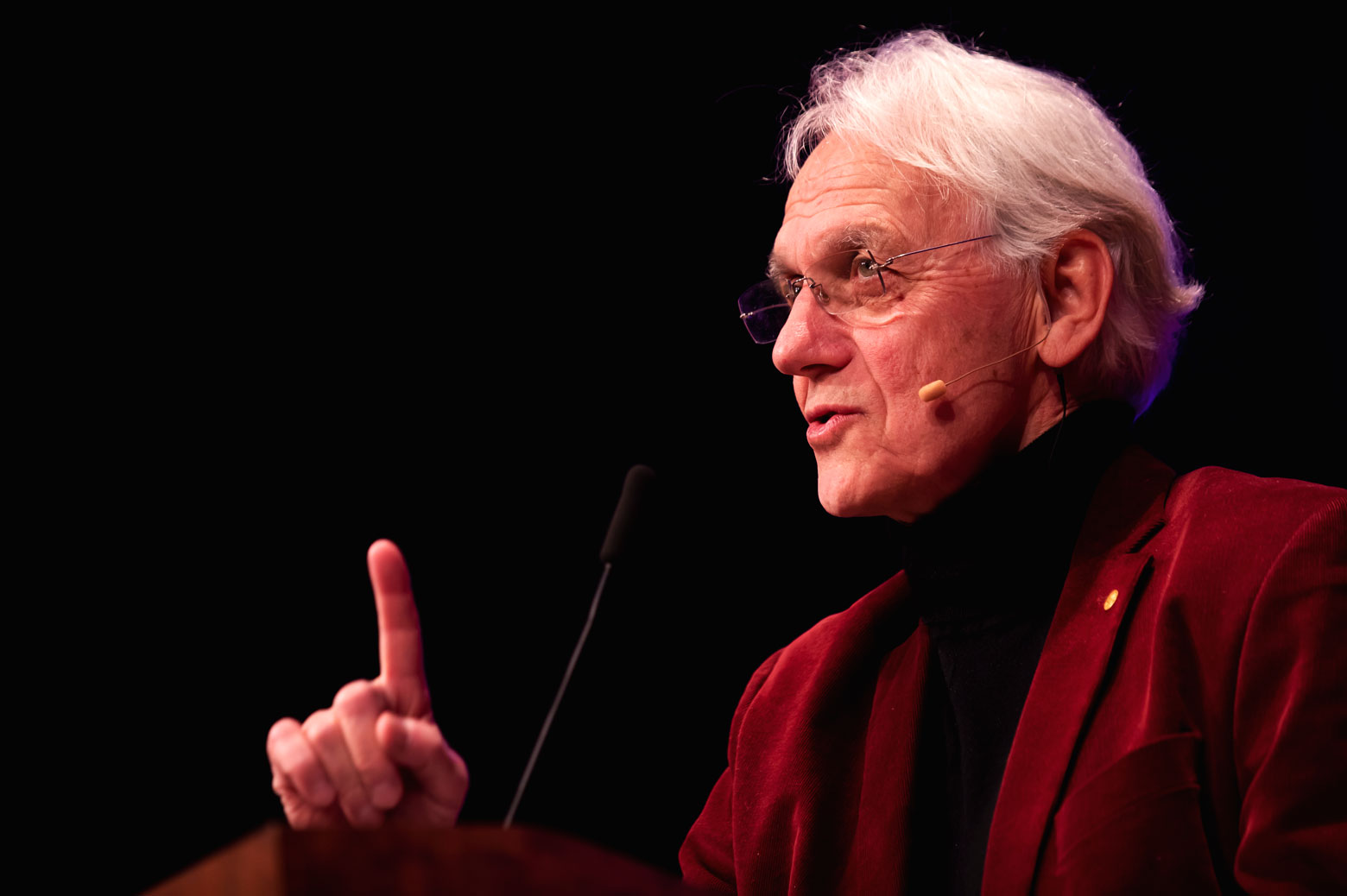
 Enlarge
Enlarge
This was Mourou’s second visit to campus since winning the Nobel Prize. He presented his Nobel lecture to the general public at Rackham Auditorium in February, and he presented the Alan J. Hunt Memorial Lecture for Biomedical Engineering at the Gerald R. Ford Presidential Library in November.
“I am very proud to be a part of the University of Michigan,” Mourou said during his talk. “The students and faculty here are just wonderful. My experience here was fantastic.”
I am very proud to be a part of the University of Michigan. The students and faculty here are just wonderful. My experience here was fantastic.
Gérard Mourou, 2018 Nobel Laureate
A few days before, Strickland presented LSA’s Ta-You Wu Lecture in Physics at Rackham Auditorium. She spoke about the history of the field as well as the development of CPA, including some unexpected challenges. For instance, in her experiments, she used a very specific length of fiber – the length of what she had left after she accidentally broke the original fiber.
“You can calculate all you want, but what’s the point when you’re going to use what you’ve got, anyway,” Strickland said.
“Even for somebody like me who really knows the physics of this stuff, it’s refreshing to have somebody make it look so fun,” Forrest said of Strickland’s talk.
Mourou also had his share of surprises in the lab. He recounted the famous event where a grad student took a laser in the eye and had to be taken to the E.R. Ronald Kurtz, M.D., then a second-year resident at U-M’s Kellogg Eye Center, examined the student and found, to his amazement, that the student’s vision wasn’t damaged, because the cuts were so precise.
“The retina was damaged, but the damage was perfectly circular,” Mourou said. “The doctor wanted to know what kind of laser we had.”
Kurtz ended up joining Mourou’s research group, and together they used the laser to develop a new kind of eye surgery called Femtosecond LASIK.
Strickland showed videos of Femtosecond LASIK eye surgery being performed during her talk, warning the audience when it got graphic, and exclaiming, “Who would do this? Isn’t this crazy?”
Strickland also addressed that she was the first woman to win the Nobel Prize in Physics in 55 years. She said that she never thought of herself as a “woman in science,” but rather as just a scientist. However, she said she’s proud to be a role model and hopes her work will help inspire future scientists.
The Friendships
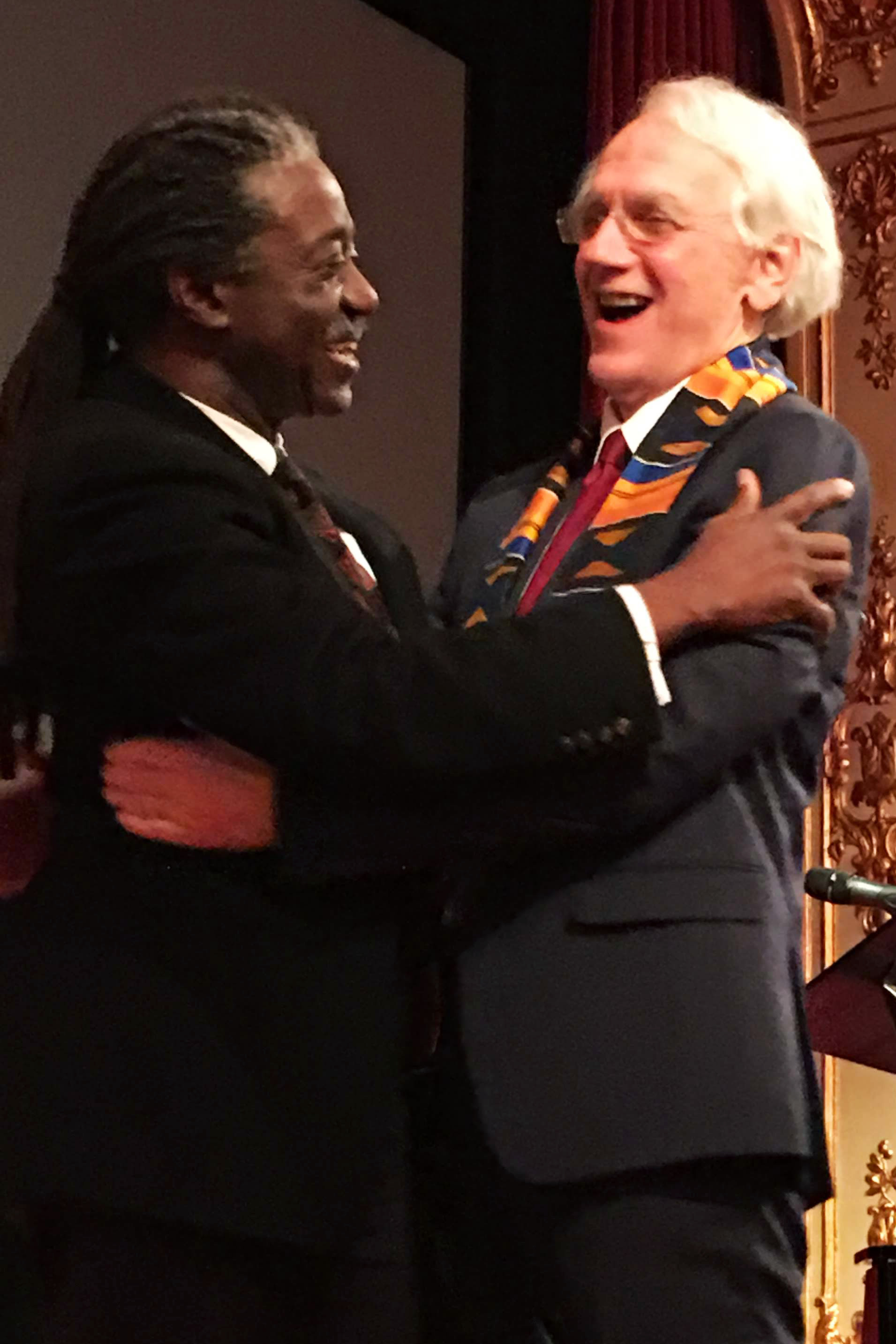
 Enlarge
Enlarge
In the nearly two decades that Mourou taught here, he became good friends with Herbert Winful, the Joseph E. and Anne P. Rowe Professor of Electrical Engineering and Arthur F. Thurnau Professor. Mourou led a team that included Ted Norris, Research Scientist John Nees, and Winful to create the Center for Ultrafast Optical Science (CUOS), now named in Mourou’s honor.
“I think the world of him, and there’s always been a certain empathy between us,” Winful said. “He’s a man of great vision, and he’s always reaching far into the future.”
In 2014, for Mourou’s 70thbirthday, Winful organized a symposium in his honor. The symposium, “From Ultrafast to Extreme Light,” drew over 200 attendees and featured 17 invited speakers including Strickland.
“I think he was really moved by that,” Winful said. “Mourou used to say I reminded him of Kofi Annan (the late UN Secretary-General), maybe because both Annan and I are from Ghana!”
While Mourou was pushing novel applications of CPA here at Michigan, Strickland had joined the technical staff of Princeton’s Advanced Technology Center for Photonics and Opto-electronic Materials where she worked under Forrest.
“She was a research scientist in my lab for about two years, and we had a jolly good time,” Forrest said.
Forrest also praised Strickland’s humility, saying that she invites people to share in her passion without coming across as egotistical.
“She has such a sense of fun, and she still feels the magic of science,” Forrest said. “So, what makes her good? That’s it.”
The Nobel Ceremony
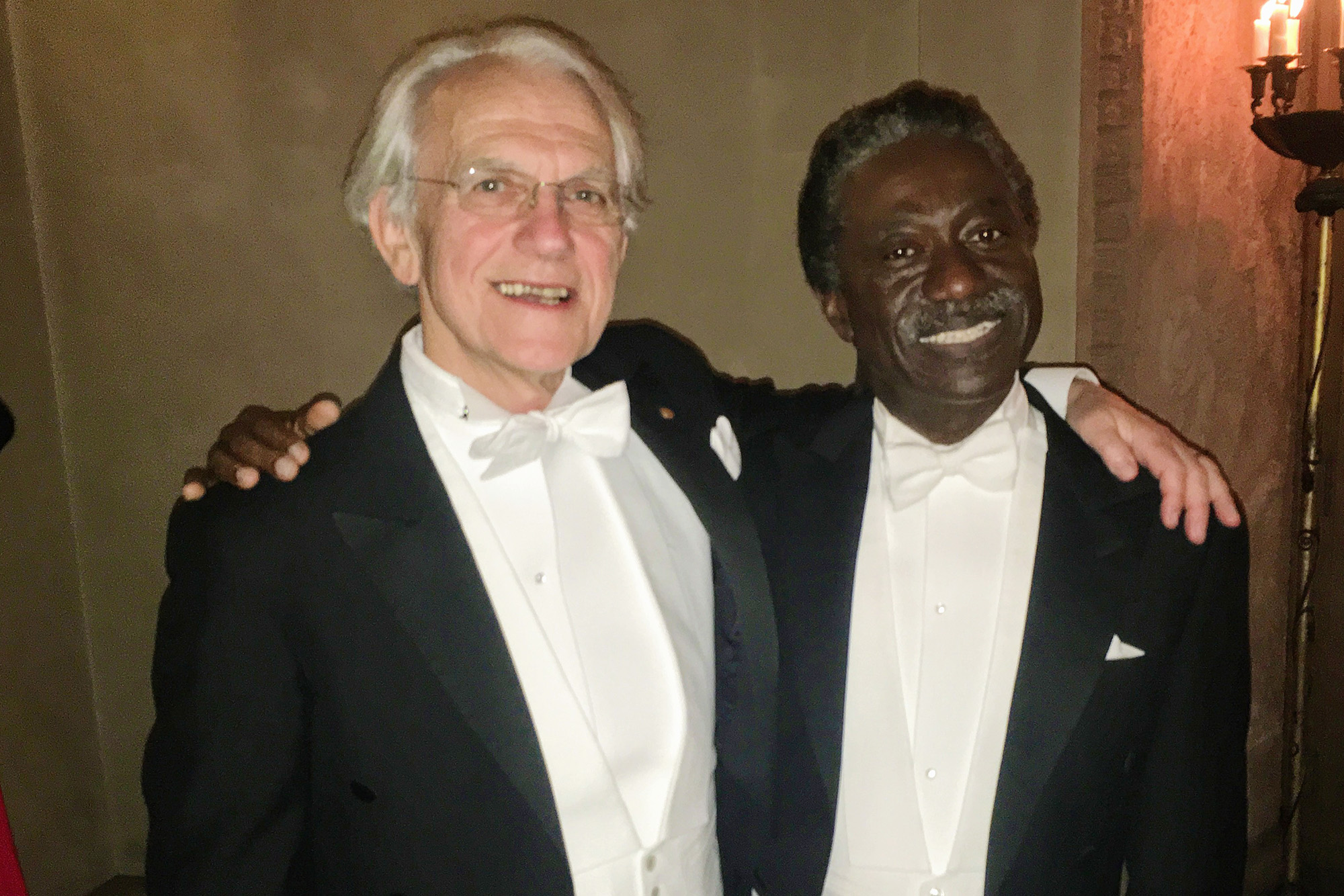
 Enlarge
Enlarge
On the bus to the Nobel Ceremony, Winful got to talking with the man seated next to him. The man told him he was there for the medical laureate.
“Are you a doctor?” Winful asked, as the bus weaved through the city awash in Christmas lights.
“No, I’m a musician,” the man said.
“Oh? Are you a composer?” Winful asked.
“No, I’m in a band,” the man answered with a smile.
“What band?”
“U2.”
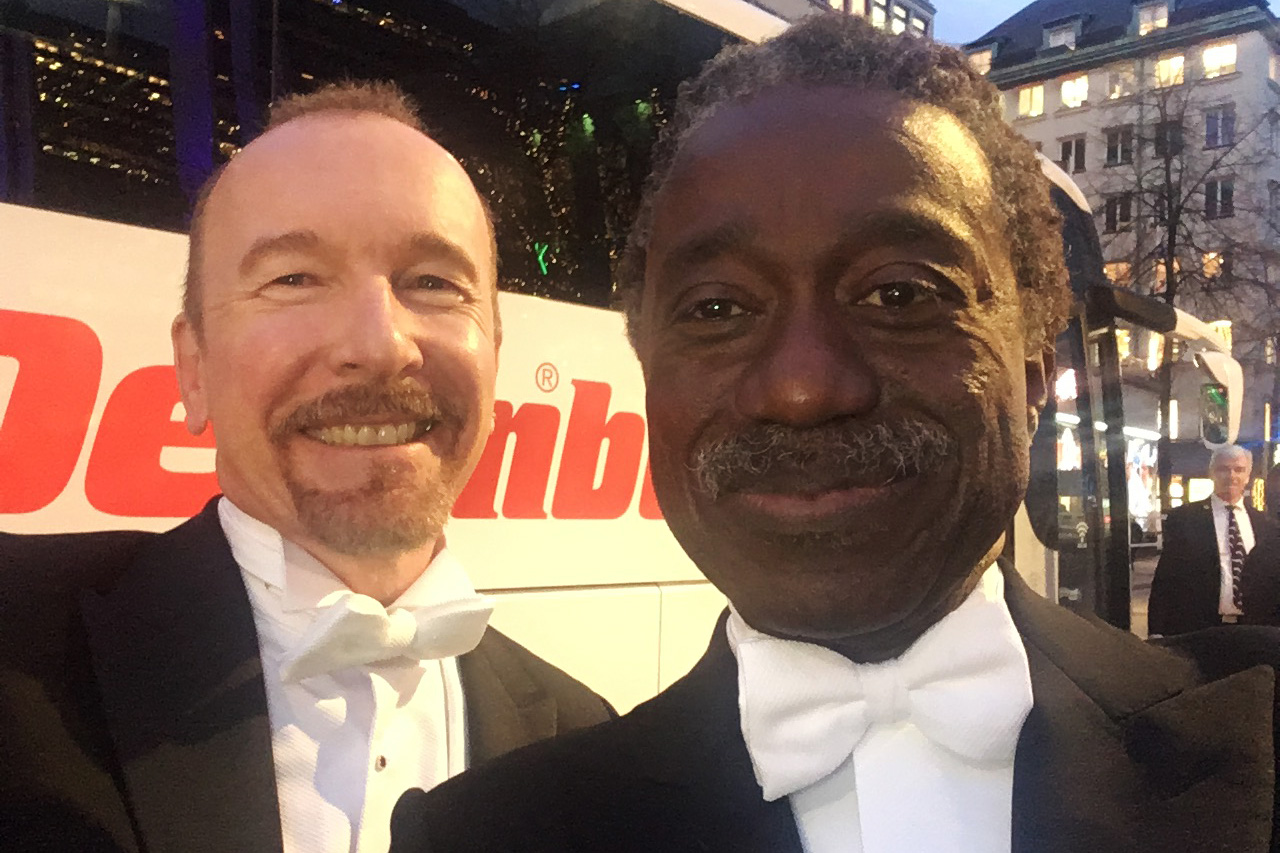
 Enlarge
Enlarge
This was, of course, a bit of a shock. Winful was seated next to none other than David Evans, otherwise known as “The Edge,” who’s been U2’s lead guitarist, keyboardist, and backing vocalist since the band’s inception. It was one of many spectacular moments Winful experienced as a guest at the most prestigious and exclusive award ceremony in the world.
Since 1901, the Nobel Prizes in Physics, Chemistry, Physiology or Medicine, and Literature have been awarded in Stockholm, Sweden, while the Nobel Peace Prize is awarded in Oslo, Norway. In Stockholm, His Majesty the King of Sweden presents each laureate with their diploma and medal. The ceremony is then followed by a banquet at the Stockholm City Hall for the laureates, their guests, and members of the Royal Family. Each laureate is allowed to bring 14 people – family, friends, colleagues – to the ceremony and banquet.
Winful was one of Mourou’s 14.
“It was the experience of a lifetime,” Winful said.
The events are as white-tie as it gets. The men wear custom-made tuxedos, and many of the women are dressed by the world’s finest designers.
“I, however, had to get my dress from a department store in Canada,” Strickland said.
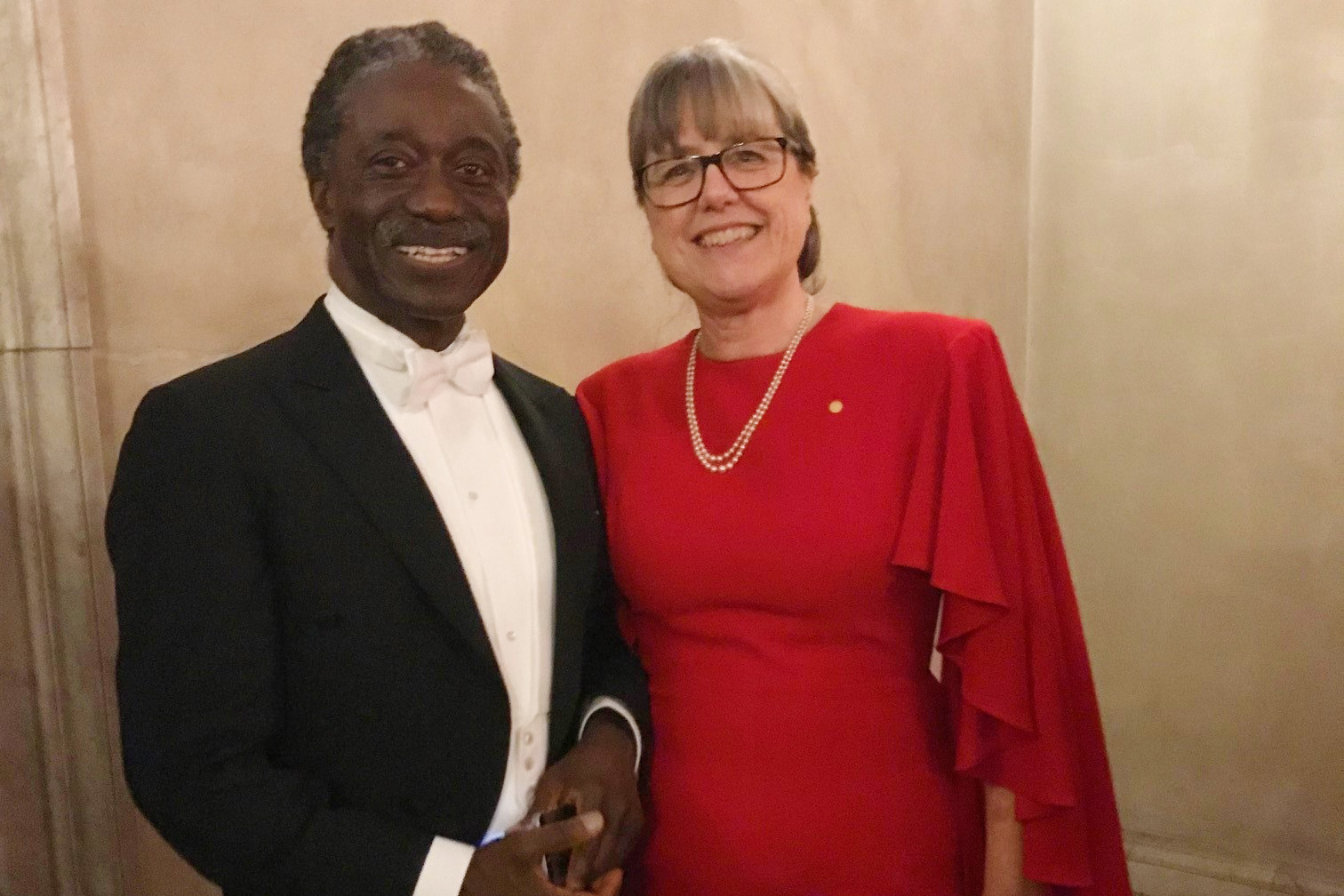
 Enlarge
Enlarge
Before the day of the ceremony and banquet, each laureate presented a lecture about their work, discoveries, and impact.
“That was the first time I had seen Gérard since the Nobel Prize,” Winful said. “It was really wonderful being able to congratulate him there and hearing him talk about the research that led to the Nobel Prize and the other great things he planned to do beyond the Nobel Prize.”
Later, Winful attended three receptions for Mourou: one at the French ambassador’s residence (“Gérard was a Rockstar there!”), one at the U.S. ambassador’s residence (where Winful ran into Ronald Kurtz, but thankfully no one had taken a laser in the eye this time), and one for all the laureates at the Nordic museum.
That evening, there was a large party held at the Grand Hotel for Strickland and Mourou, where over 300 of their friends, family, and colleagues came to celebrate. Norris and Nees, while not attending the main ceremony, joined the gathering in support of Mourou. That evening, Winful gifted Mourou a piece of Kente cloth, which is a Ghanaian fabric worn in celebration.
“Gérard wore it all night,” Winful said.
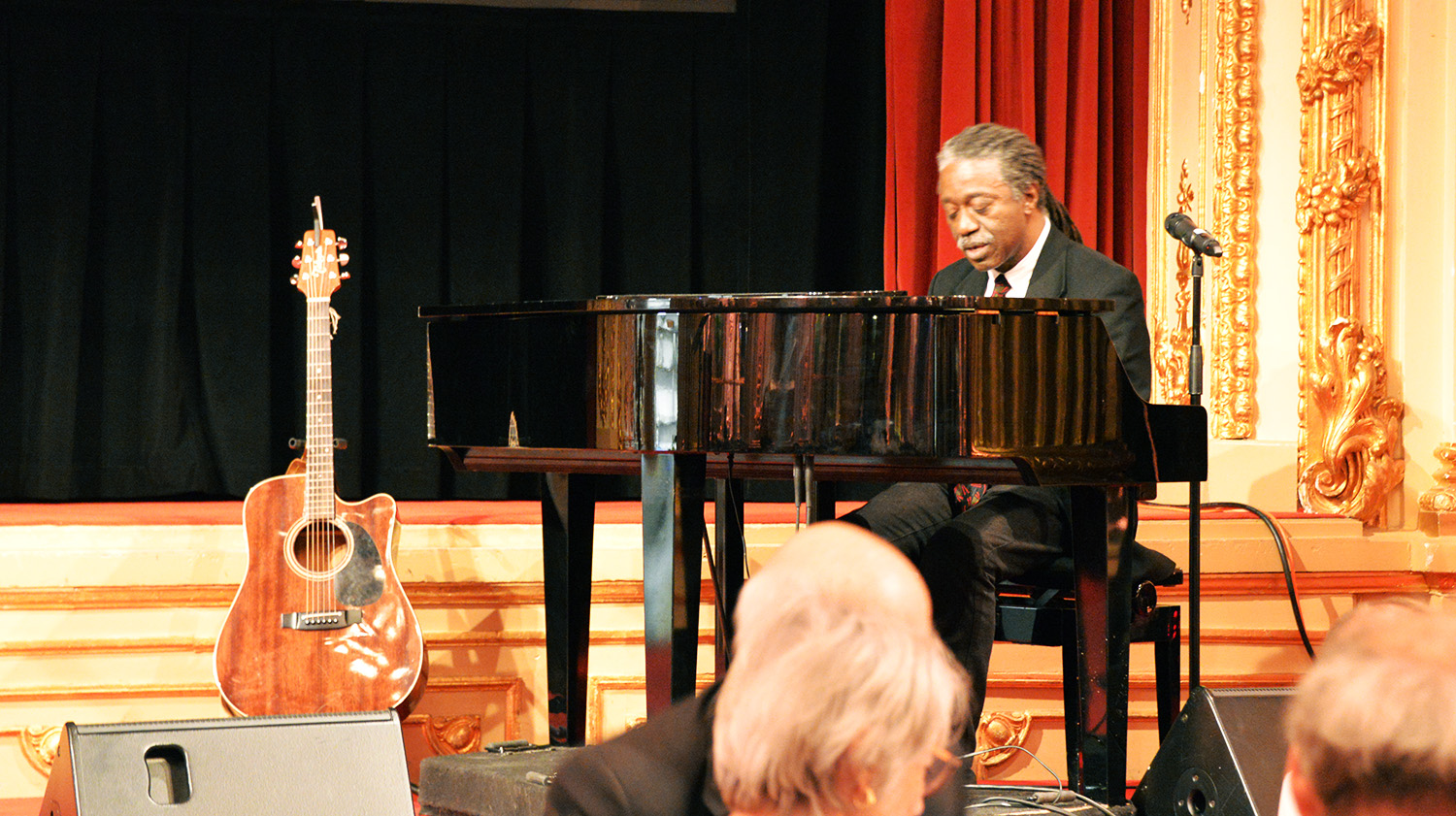
 Enlarge
Enlarge
Winful was one of several people who addressed the crowd that night, and he even played one of his original compositions on the piano per Prof. and Mrs. Mourou’s requests. A relative of Mourou’s also played the guitar and asked if someone would come up and sing along Bob Marley’s “Redemption Song.”
“I wasn’t about to volunteer,” Winful confessed, but he was immediately championed by a fellow attendee who was more than happy to provide him with the lyrics via google.
“Like a fool, I went up there,” Winful said. “It wasn’t even my key. I made a mess of it, but the young man was so pleased, so happy, that someone actually came to sing while he played the guitar.”
Then the day of the Nobel Ceremony arrived. While Winful and The Edge were bonding on the bus, the Nobel laureates arrived via private cars. The Nobel laureates in Physics are always first, as that prize is considered the most prestigious. Laureates are then arranged in alphabetical order in each category. Since Arthur Ashkin, the third Nobel laureate in physics that year, was unable to attend, Mourou was slotted for the first car. However, Mourou gave his permission for Strickland to take his place. Strickland then became the first female laureate in history to arrive in the first car.
When Strickland stepped out of the car onto the steps of the Stockholm Concert Hall, her attaché informed her that there was even more history being made that day. The attaché was the first woman to accompany the lead laureate, and their driver was the first woman to drive the lead car. The conductor of the ceremony’s orchestra was also a woman.
The King presented the medal and diploma to each laureate, beginning with Strickland and Mourou.
“Watching my friend and colleague receive a prize by the hands of the King was a moment I will never forget,” Winful said.
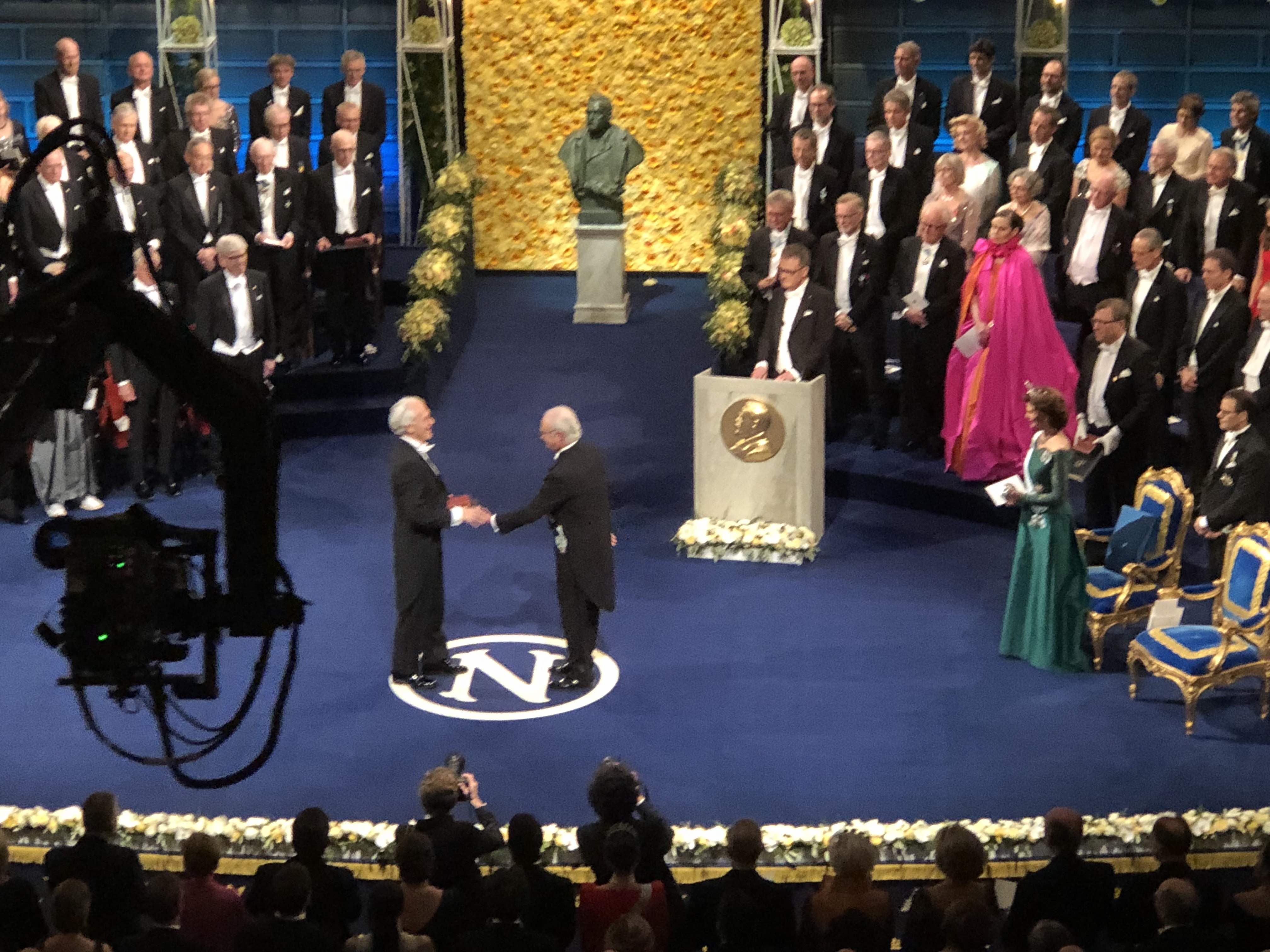
 Enlarge
Enlarge
After the ceremony, the guests were brought to the banquet in City Hall – a long, elegant, golden room. The physics laureates were escorted in first, with Strickland escorted by the King himself. Mourou arrived with Princess Sofia and sat between the Queen and the Princess during dinner. Winful describes the eight-course meal as “exquisite,” and his favorite dish was, unsurprisingly, dessert.
After the banquet there was dancing and then an afterparty that went on well past midnight.
“The whole evening was like an out-of-body experience,” Winful said.
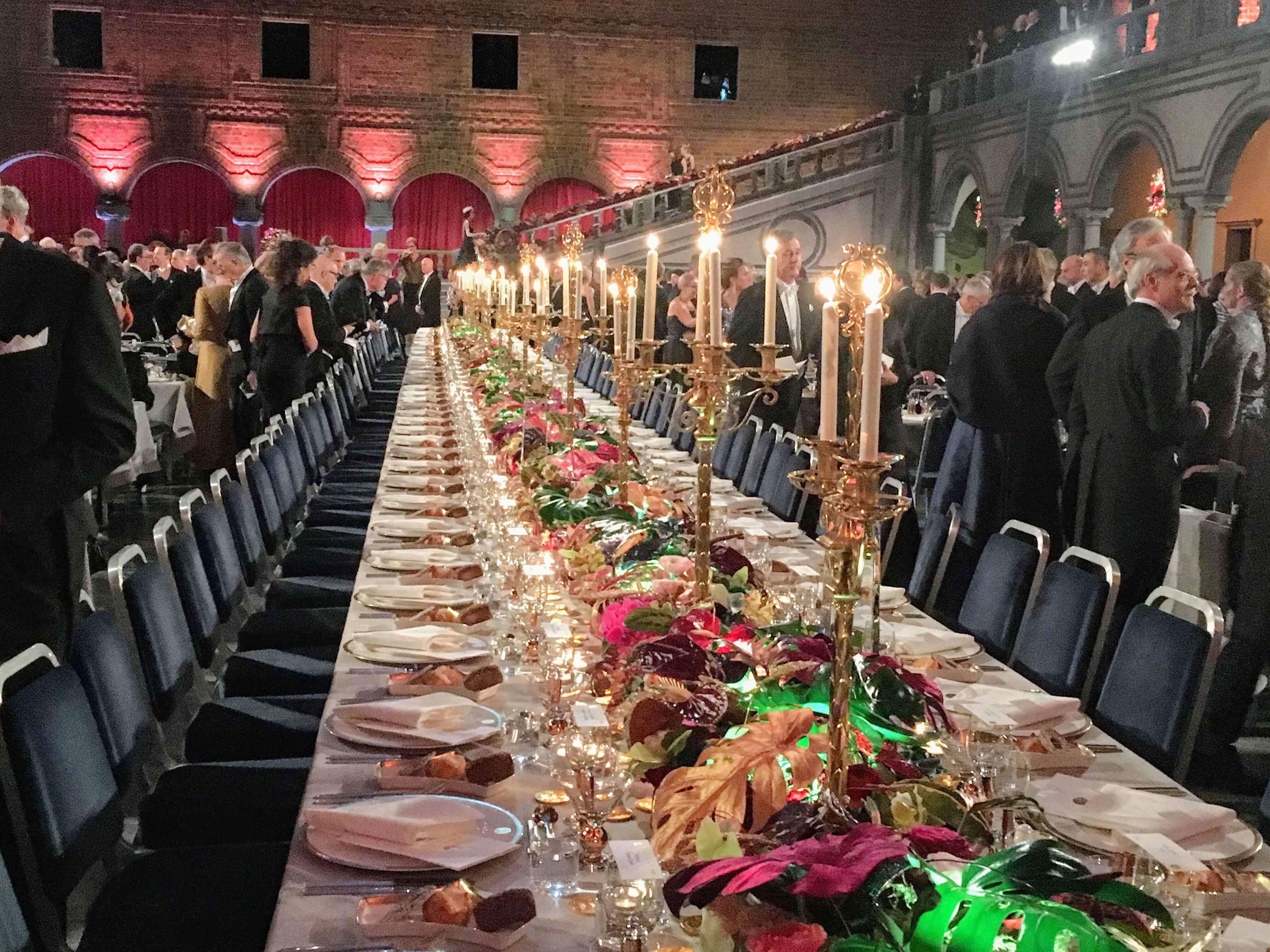
 Enlarge
Enlarge
 MENU
MENU 
